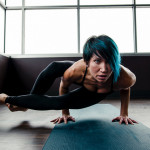How to do it
The best approach to do this position is on a yoga mat. Use a surface that enables you to get into position without sliding your feet if you don't have a mat. The transition from Downward Facing Dog to Revolved Side Angle is part of a sequence.
Step your leg forward to a lunge from Downward-Facing Dog. Your hips should be squared to the front of your mat. Maintain a 90-degree angle with your left knee. Align your right ankle's center with the center of your kneecap. Bring the right thigh parallel to the floor if feasible.
Warrior I is performed by lifting the body and raising the arms above. Reach your arms up to the sky and generate length between your hip points and armpits to create space in your torso. Take a few deep breaths and pause here. Bring your arms down to your sides, palms together in Anjali mudra, and your thumbs to your breastbone.
Bring your right forearm to the outside of your left knee and twist your whole body leftwards. As you push your right arm onto the outside of your kneecap, place your right arm on the floor or a block. With your palm towards the floor, extend your left hand upwards or out over your left ear. Work on putting your back heel on the ground. (It may not get there right away.)
Breathe deeply, twisting a bit more as you exhale and stretching your spine as you inhale. Lengthen and soften your belly with each inhale, stretch your spine, and enhance the twist as you exhale. Hold your breath for 5 to 10 seconds. If your back heel isn't already down, do it now and pull your left arm out of the stance before repeating on the other side.
Inhale to lift yourself up and exhale to let go of the twist. Reverse your feet and repeat on the other side for the same amount of time.
Variations
You can modify this pose to match your strength and flexibility.
Altered Neck Position
Keep your neck in a neutral posture if necessary to avoid straining your cervical spine (the seven bones in the neck region of the spine). If you experience neck sensitivity, look ahead rather than up.
Lifted Heel Position
Another option is to keep your right foot on the ball of your foot rather than sinking your right heel. This puts the leg in a lunge-like posture, gentler on the back knee.
Different Arm Position
If the usual posture doesn't feel comfortable or creates strain, you may adjust your arms in various ways. For example, the lower hand may travel outside or inside the front foot. Alternatively, the upper arm may be over your ear or straight up.
Place a block beneath your right hand if it doesn't reach the floor comfortably so you can still benefit from the twist. Rather than bringing your right-hand flat, you may remain on your fingers.
Benefits
- Stretches and strengthens the knees, legs, and ankles.
- Improves stamina.
- The groins, spine, chest and lungs, and shoulders are stretched.
- Balance is improved.
- Stimulates the organs of the abdomen.
- Helps with digestion and elimination.













